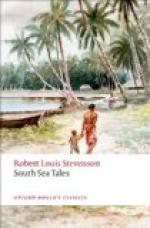CHAPTER V—DEPOPULATION
Over the whole extent of the South Seas, from one tropic to another, we find traces of a bygone state of over-population, when the resources of even a tropical soil were taxed, and even the improvident Polynesian trembled for the future. We may accept some of the ideas of Mr. Darwin’s theory of coral islands, and suppose a rise of the sea, or the subsidence of some former continental area, to have driven into the tops of the mountains multitudes of refugees. Or we may suppose, more soberly, a people of sea-rovers, emigrants from a crowded country, to strike upon and settle island after island, and as time went on to multiply exceedingly in their new seats. In either case the end must be the same; soon or late it must grow apparent that the crew are too numerous, and that famine is at hand. The Polynesians met this emergent danger with various expedients of activity and prevention. A way was found to preserve breadfruit by packing it in artificial pits; pits forty feet in depth and of proportionate bore are still to be seen, I am told, in the Marquesas; and yet even these were insufficient for the teeming people, and the annals of the past are gloomy with famine and cannibalism. Among the Hawaiians—a hardier people, in a more exacting climate—agriculture was carried far; the land was irrigated with canals; and the fish-ponds of Molokai prove the number and diligence of the old inhabitants. Meanwhile, over all the island world, abortion and infanticide prevailed. On coral atolls, where the danger was most plainly obvious, these were enforced by law and sanctioned by punishment. On Vaitupu, in the Ellices, only two children were allowed to a couple; on Nukufetau, but one. On the latter the punishment was by fine; and it is related that the fine was sometimes paid, and the child spared.
This is characteristic. For no people in the world are so fond or so long-suffering with children—children make the mirth and the adornment of their homes, serving them for playthings and for picture-galleries. ’Happy is the man that has his quiver full of them.’ The stray bastard is contended for by rival families; and the natural and the adopted children play and grow up together undistinguished. The spoiling, and I may almost say the deification, of the child, is nowhere carried so far as in the eastern islands; and furthest, according to my opportunities of observation, in the Paumotu group, the so-called Low or Dangerous Archipelago. I have seen a Paumotuan native turn from me with embarrassment and disaffection because I suggested that a brat would be the better for a beating. It is a daily matter in some eastern islands to see a child strike or even stone its mother, and the mother, so far from punishing, scarce ventures to resist. In some, when his child was born, a chief was superseded and resigned his name; as though, like a drone, he had then fulfilled




